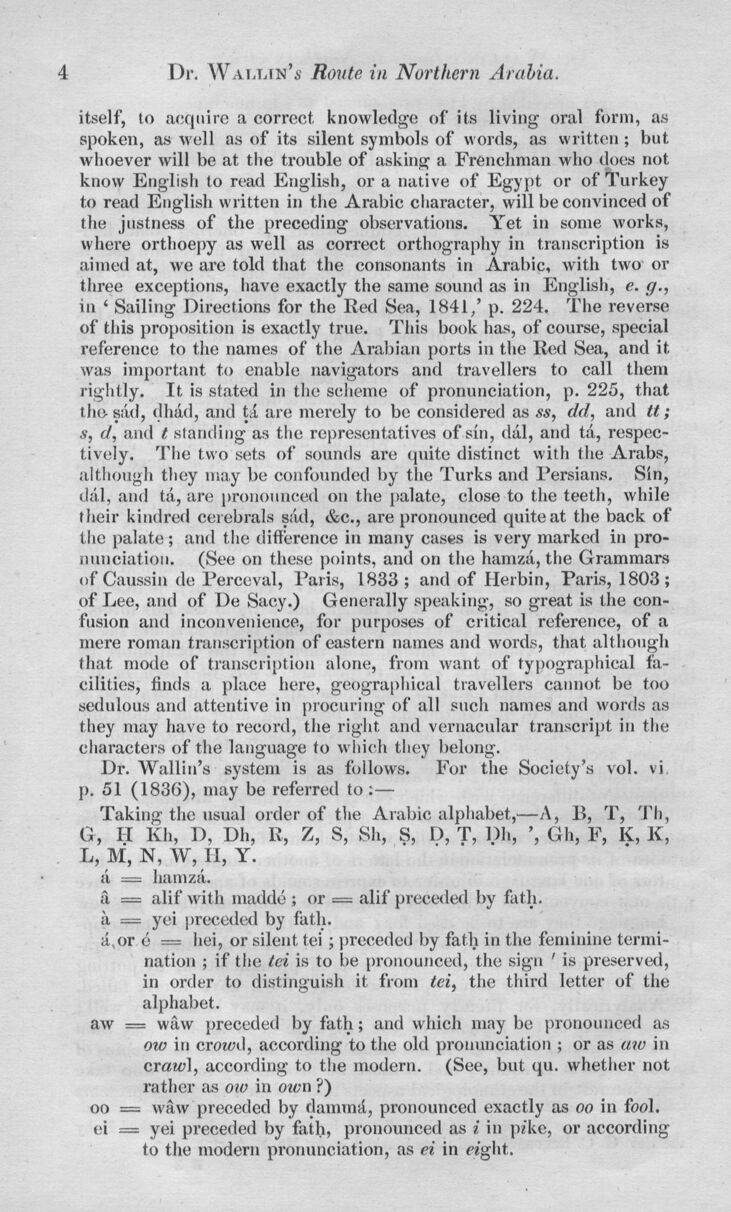
Full resolution (JPEG) - On this page / på denna sida - Route in Northern Arabia

<< prev. page << föreg. sida << >> nästa sida >> next page >>
Below is the raw OCR text
from the above scanned image.
Do you see an error? Proofread the page now!
Här nedan syns maskintolkade texten från faksimilbilden ovan.
Ser du något fel? Korrekturläs sidan nu!
This page has been proofread at least once.
(diff)
(history)
Denna sida har korrekturlästs minst en gång.
(skillnad)
(historik)
itself, to acquire a correct knowledge of its living oral form, as
spoken, as well as of its silent symbols of words, as written; but
whoever will be at the trouble of asking a Frenchman who does not
know English to read English, or a native of Egypt or of Turkey
to read English written in the Arabic character, will be convinced of
the justness of the preceding observations. Yet in some works,
where orthoepy as well as correct orthography in transcription is
aimed at, we are told that the consonants in Arabic, with two or
three exceptions, have exactly the same sound as in English, e. g.,
in ‘Sailing Directions for the Red Sea, 1841,’ p. 224. The reverse
of this proposition is exactly true. This book has, of course, special
reference to the names of the Arabian ports in the Red Sea, and it
was important to enable navigators and travellers to call them
rightly. It is stated in the scheme of pronunciation, p. 225, that
the ṣád, ḍhád, and ṭá are merely to be considered as ss, dd, and tt;
s, d, and t standing as the representatives of sín, dál, and tá,
respectively. The two sets of sounds are quite distinct with the Arabs,
although they may be confounded by the Turks and Persians. Sín,
dál, and tá, are pronounced on the palate, close to the teeth, while
their kindred cerebrals ṣád, &c., are pronounced quite at the back of
the palate; and the difference in many cases is very marked in
pronunciation. (See on these points, and on the hamzá, the Grammars
of Caussin de Perceval, Paris, 1833; and of Herbin, Paris, 1803;
of Lee, and of De Sacy.) Generally speaking, so great is the
confusion and inconvenience, for purposes of critical reference, of a
mere roman transcription of eastern names and words, that although
that mode of transcription alone, from want of typographical
facilities, finds a place here, geographical travellers cannot be too
sedulous and attentive in procuring of all such names and words as
they may have to record, the right and vernacular transcript in the
characters of the language to which they belong.
Dr. Wallin’s system is as follows. For the Society’s vol. vi.
p. 51 (1836), may be referred to :—
Taking the usual order of the Arabic alphabet,—A, B, T, Th,
G, Ḥ Kh, D, Dh, R, Z, S, Sh, Ṣ, Ḍ, Ṭ, Ḍh, ’, Gh, F, Ḳ, K,
L, M, N, W, H, Y.
á = hamzá.
â = alif with maddé; or = alif preceded by fatḥ.
à = yei preceded by fatḥ.
á or é = hei, or silent tei; preceded by fatḥ in the feminine
termination; if the tei is to be pronounced, the sign ′ is preserved,
in order to distinguish it from tei, the third letter of the
alphabet.
aw = wâw preceded by fatḥ; and which may be pronounced as
ow in crowd, according to the old pronunciation; or as aw in
crawl, according to the modern. (See, but qu. whether not
rather as ow in own?)
oo = wâw preceded by dammá, pronounced exactly as oo in fool.
ei = yei preceded by fatḥ, pronounced as i in pike, or according
to the modern pronunciation, as ei in eight.
<< prev. page << föreg. sida << >> nästa sida >> next page >>